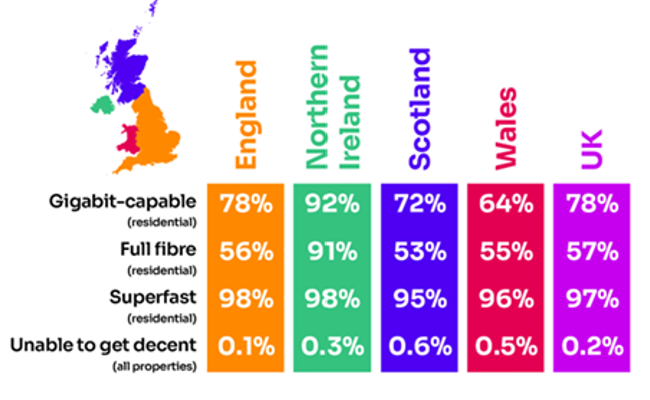
- Nearly 750,000[1] homes in Northern Ireland have access to the full-fibre broadband, over 51,000 more than last year
- Average broadband download speeds in Northern Ireland have increased by 50%
- 5G availability is gathering pace
Nearly three quarters of a million Northern Ireland homes have access to full-fibre broadband – higher than all other UK nations, according to Ofcom’s latest Connected Nations report published today.
Full-fibre broadband uses fibre all the way to your home. It is more reliable and resilient than copper, and our new analysis shows that some providers experience fewer faults[2] on their fibre network compared with a copper-based network. Gigabit capable networks, which include both full fibre and cable, also deliver faster upload and download speeds.
For the first time, full-fibre broadband is available to over half of homes in all four of the UK nations. Northern Ireland leads the way, with over nine in 10 homes (91%) able to get full fibre.

Nearly two-fifths, (39%) of homes and businesses in Northern Ireland that can access full fibre have taken it up.
The rapid rise in availability of full-fibre broadband is good news for people and businesses in Northern Ireland, with nearly three quarters of a million homes now able to benefit from fast, reliable and future-proof internet.
With further publicly funded investment planned to deliver fast broadband to hard-to-reach areas, Northern Ireland is well on the way towards full-fibre availability for all.
Jonathan Rose, Ofcom’s Director for Northern Ireland
With households in Northern Ireland now using 568 GB of broadband data a month on average, full fibre can better support homes with multiple people working, gaming and video-calling at the same time.
Picking up pace
Average broadband download speeds in Northern Ireland have increased by 50% to 173 Mbit/s, up from 115 Mbit/s last year, and reflects the increased availability and take-up of faster broadband services.
High-speed internet services becoming more accessible in recent years is a result of continued significant commercial and publicly funded investment in fibre networks.
The Northern Ireland Executive’s broadband scheme Project Stratum is aimed at rural areas is progressing at pace, while Openreach, Virgin Media and Fibrus continue with commercial deployments to urban and semi-rural areas.
The Department for the Economy (DfE) is now preparing for the implementation of Project Gigabit in Northern Ireland, which will look to serve premises not within the scope of Project Stratum and are outside of indicated commercial deployment plans. The combination of commercial investment and public intervention is expected to result in near ubiquitous gigabit connectivity for Northern Ireland.
A rise in full-fibre coverage over the last year is most notable in several, mainly rural council areas. In Fermanagh and Omagh, full-fibre coverage now extends to some 85% of residential premises, up from 71% a year ago. Full-fibre coverage in Mid Ulster is now 88%, up from 75% a year ago.
Rollout of 5G mobile coverage continues
The availability of 5G continues to grow rapidly, with estimated coverage provided outside of Northern Ireland premises by at least one mobile network operator at over 70% [3] – a rise on last year’s 37%.
4G coverage continues to provide the backbone of mobile experience for consumers. Individual operators provide 4G coverage across most of Northern Ireland, with geographic mobile coverage ranging from 88-92%, depending on the operator.
Notes:
- More than 747,000 homes in Northern Ireland now have access to full-fibre broadband.
- Over the last three years, for both KCOM and Openreach, the fault rate (per 1,000 connections) on KCOM‘s copper access network (ADSL) and Openreach‘s copper access networks (ADSL / VDSL) was around 50% higher than the fault rates on their respective FTTP networks.
- Refers to very high confidence of 5G coverage outside of premises in Northern Ireland from at least one mobile network operator.
